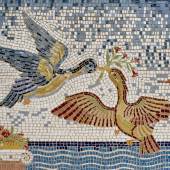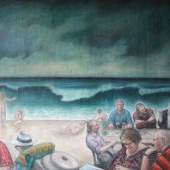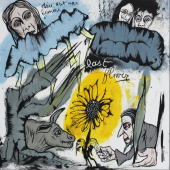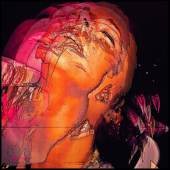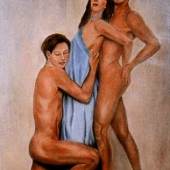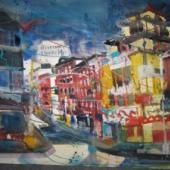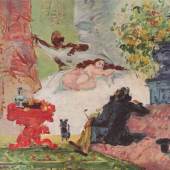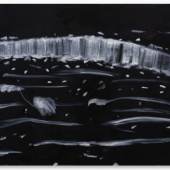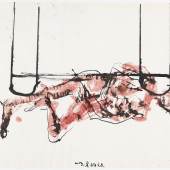Georg Baselitz La boussole indique le nord
-
Ausstellung22.01.2023 - 27.05.2023
La boussole indique le nord is an exhibition of recent works by internationally renowned German artist Georg Baselitz. Filling the gallery’s Paris Pantin space, the exhibition brings together five series realised between 2020 and 2021, in celebration of the artist’s 85th birthday. The works on view span 'Tulips' with pared-back compositions and contrasting colours, three series of portraits with vivid palettes, and a series of more melancholy portraits on dark backgrounds. The works on canvas are accompanied by a group of ink drawings. Characterised by an unprecedented integration of fabric and by a transfer method that marks a significant recent development in Baselitz’s technique, the works create, both conceptually and materially, a distinctive universe where the logic of collage coalesces with painting.
Baselitz’s wife Elke has been a constant subject of the artist’s work throughout his career, ever since he first painted her in 1969. Showing her from the waist up, her head resting on her hand, the group of new portraits in the exhibition pays homage to Baselitz’s very first depiction of her, which is today part of the collection of The Metropolitan Museum of Art in New York. Those from 2021 also feature a new element in Baselitz’s visual vocabulary: a disjointed pair of nylon stockings affixed to the upside-down portrait of Elke, like fragile, disembodied legs. Existing on a different plane to the oil-painted figures, they give the canvases a third dimension, expanding them into the realm of collage to evoke the work of German Dadaist Hannah Höch, who employed cut-out legs to construct mismatched bodies in her pioneering photo collages. Interviewed in the NZZ am Sonntag in 2022, Baselitz said: ‘Some two years ago I remembered Hannah Höch and her stocking pictures. I had never dared to make collages before. I found the technique wonderful. But the question was: how could I use this technique in my painting? Then I had a dream about the stockings.’
With a touch of playfulness, the stockings recall the feet and legs that have been a recurring theme since the artist’s very early works. For Baselitz, they are the symbol of a tactile connection with the earth: the same connection he fosters by working with his canvases on the floor. Interviewed by Martin Schwander in 2017, Baselitz explained that, as a ‘north-of-the-Alps man’, his contact does not reach heavenward: ‘The Mediterranean peoples [...] told us about angels in Heaven. I don’t believe in that. So, when I’m painting on the floor, the contact downward – feeling for what is under it – is really important.’ As the artist added in 2021, ‘people living north of the Alps are in search of their own story’, grounded in their own earthy mythology. The exhibition, whose title translates as The Compass Points North, might be viewed in light of this reflection.
As if in defiance of the ambiguous sensuality of the garment, the empty stockings on view seem to confront us with absence. This sense of evanescence is mirrored in the sparsity of the painted surfaces among the works in the exhibition, which contrast with the dense impasto for which Baselitz has long been known. Across the works on view, the artist uses a monotype printing technique he has developed in recent years. He paints the composition onto a piece of unstretched canvas before pressing a second canvas against it while wet, to create a mirror-image impression. Here, compared to previous works, Baselitz’s ‘figures dissolve more and more’, remarks art critic Gerhard Mack. ‘The colour becomes transparent [and the] figures are almost floating, porous’.
Baselitz takes his monotype technique a step further in his intensely chromatic portraits with stockings, transferring the figure of Elke onto a piece of fabric which he then affixes to the canvas. Allowing the creases of the fabric to mirror the delicate folds of skin, this unprecedented technique brings to mind the imprint left by Christ’s body on the Shroud of Turin. Impregnated with her form, the printed fabric implies an imagined contact with Elke’s body, turning painting into, as art historian Philippe Dagen writes in the catalogue accompanying the exhibition, ‘not an image [...] but the material manifestation of a presence’. The disarming corporeal intimacy this creates is echoed in the delicate depictions of Elke found in the group of ink drawings on view, in which slight outlines wind across the exposed paper like veins laid bare. Across the exhibition, Baselitz associates this bodily vitality, expressed through jubilant colour and gestural energy, with the fragility of his representation of a beloved figure in all her vulnerability, to create portraits in which vigour is tempered with tenderness.
The exhibition is dominated by the vibrant palette of the portraits in effervescent colours on white grounds, as well as those painted on powder blue. The latter evoke the blue backgrounds of German Renaissance painter Lucas Cranach the Elder’s portraits, as well as the cyan environments characteristic of Pablo Picasso’s Surrealist nudes from the 1920s and 30s, bearing witness to Baselitz’s constant engagement with the history of painting. Such bursts of works in intense colour are always matched in the artist’s practice by periods in which a more subdued palette dominates. The series of monumental canvases on impenetrable backgrounds of black brushstrokes bears witness to this duality.
-
09.09.2021 - 13.09.2021The upcoming edition of Maison&Objet Paris will take place from the 9th to the 13th of...
-
08.11.2023 - 12.11.2023Paris Photo, the leading international fair dedicated to photography, announces its premiere line...
-
13.09.2019 - 17.09.2019La Biennale Paris 2019 will be held at the Grand Palais from 13 to 17 September 2019,...
-
Grand Palais – Gründung, Geschichte, Stil und bedeutende Künstler Der Grand Palais wurde im...
-
Der deutsch-französische Krieg beeinflusst natürlich auch das künstlerische Leben...
-
15.02.2025 - 12.04.2025I am trying to make paintings that have some real energy – the here and now. It’s...
-
01.03.2025 - 19.04.2025Oliver Beer präsentiert seine Resonance Paintings: The Cave erstmals in der Galerie Thaddaeus...
-
22.01.2023 - 27.05.2023
Opening
Tuesday 21 June 2022, 6—8pm
With the artist present21 June—30 July 2022
Paris Marais
7, rue Debelleyme
75003 Paris, France
